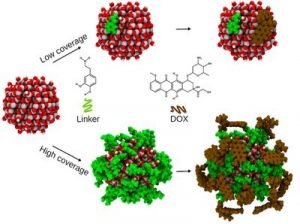Computational nanomedicine
web site: nanoQlab
The research activity of the group in the field of nanomedicine is focused on the modeling and simulation of bioinorganic nanodevices for drug delivery, imaging, targeting and cancer therapy.
permanent staff: Cristiana Di Valentin and Lorenzo Ferraro
non permanent staff: Paulo Siani, Federico Soria, Enrico Bianchetti, Anu Baby, Aldo Ugolotti, Daniele Perilli
The investigations are based on quantum mechanical (QM), tight-binding, and molecular mechanics (MM) classical calculations. We also use multiscale approaches, such as QM/MM, to reach realistic size of the models for comparison with experiments.

The activity is organized in several research topics:
PHOTOACTIVE NANOPARTICLES:
semiconducting oxide nanoparticles and nanostructures (thin films or nanotubes) are modeled as interesting stimuli-response nanodevices that are sensitive to light irradiation.
MAGNETIC NANOPARTICLES:
iron oxide nanoparticles are characterized by high magnetic moments that can be used to trace them in the organs and tissues. Saturation magnetization can be tuned by shaping nanoparticles or by means of tailored functionalization.

2D MATERIALS:
graphene, graphene oxide and other 2D nanostructures are useful platforms that can be used as carriers for drug transport and delivery.
POLYMERS COATING OF NPs:
polymer coating for the stabilization of nanosystems in biological media is a crucial aspect and can be highly improved by the use of proper linkers.

NPs FUNCTIONALIZATION:
computational modeling of nanoparticles functionalization allows to screen different molecular system, investigate their effect on the system chemical electronic and magnetic properties and suggest novel approaches to surface chemistry for different purposes. Multifunctionalization can also be explored.

NPs IN AQUEOUS ENVIRONMENT:
the interplay between the nanosystems and the aqueous environment has crucial consequences on the structural and chemical properties of the nanoconjugates and is analyzed through molecular dynamics studies where the effect of temperature is taken into account.

BIOMEMBRANES PERMEATION:
the permeation of the bioinorganic nanoconjugates through biomembranes is a key step in all biomedical application and can be improved by design of an efficacious surface functionalization.
Publications
Selli, D., Motta, S., Di Valentin, C.; Impact of surface curvature, grafting density and solvent type on the PEGylation of titanium dioxide nanoparticles (2019) Journal of Colloid and Interface Science, 555, pp. 519-531.
Liu, H., Di Valentin, C.; Shaping Magnetite Nanoparticles from First Principles (2019) Physical Review Letters, 123 (18), art. no. 186101.
Selli, D., Tawfilas, M., Mauri, M., Simonutti, R., Di Valentin, C.; Optimizing PEGylation of TiO2 Nanocrystals through a Combined Experimental and Computational Study (2019) Chemistry of Materials, 31 (18), pp. 7531-7546.
Kaviani, M., Di Valentin, C.; Rational design of nanosystems for simultaneous drug delivery and photodynamic therapy by quantum mechanical modeling (2019) Nanoscale, 11 (33), pp. 15576-15588.
Ronchi, C., Datteo, M., Kaviani, M., Selli, D., Di Valentin, C.; Unraveling Dynamical and Light Effects on Functionalized Titanium Dioxide Nanoparticles for Bioconjugation (2019) Journal of Physical Chemistry C, 123 (15), pp. 10130-10144.
Ronchi, C., Selli, D., Pipornpong, W., Di Valentin, C.; Proton Transfers at a Dopamine-Functionalized TiO2 Interface (2019) Journal of Physical Chemistry C, 123 (13), pp. 7682-7695.
Liu, H., Seifert, G., Di Valentin, C.; An efficient way to model complex magnetite: Assessment of SCC-DFTB against DFT (2019) Journal of Chemical Physics, 150 (9), art. no. 094703.
Dohn, A.O., Selli, D., Fazio, G., Ferraro, L., Mortensen, J.J., Civalleri, B., Di Valentin, C.; Interfacing CRYSTAL/AMBER to optimize QM/MM Lennard–Jones parameters for water and to study solvation of TiO2 nanoparticles (2018) Molecules, 23 (11), art. no. 2958.
Fazio, G., Selli, D., Ferraro, L., Seifert, G., Di Valentin, C.; Curved TiO2 Nanoparticles in Water: Short (Chemical) and Long (Physical) Range Interfacial Effects (2018) ACS Applied Materials and Interfaces, 10 (35), pp. 29943-29953.
Liu, H., Di Valentin, C.; Bulk-terminated or reconstructed Fe3O4 (001) surface: Water makes a difference (2018) Nanoscale, 10 (23), pp. 11021-11027.
Datteo, M., Liu, H., Di Valentin, C. ; Water on Graphene-Coated TiO2: Role of Atomic Vacancies (2018) ACS Applied Materials and Interfaces, 10 (6), pp. 5793-5804. Shirai, K., Fazio, G., Sugimoto, T., Selli, D., Ferraro, L., Watanabe, K., Haruta, M., Ohtani, B., Kurata, H., Di Valentin, C., Matsumoto, Y.; Water-Assisted Hole Trapping at the Highly Curved Surface of Nano-TiO2 Photocatalyst (2018) Journal of the American Chemical Society, 140 (4), pp. 1415-1422.
Selli, D., Fazio, G., Di Valentin, C.; Using density functional theory to model realistic TiO2 nanoparticles, their photoactivation and interaction with water (2017) Catalysts, 7 (12), art. no. 357.
Liu, H., Di Valentin, C.; Band Gap in Magnetite above Verwey Temperature Induced by Symmetry Breaking (2017) Journal of Physical Chemistry C, 121 (46), pp. 25736-25742.
Selli, D., Fazio, G., Di Valentin, C.; Modelling realistic TiO2 nanospheres: A benchmark study of SCC-DFTB against hybrid DFT (2017) Journal of Chemical Physics, 147 (16), art. no. 164701.
Selli, D., Di Valentin, C.; Ab initio investigation of polyethylene glycol coating of TiO2 surfaces (2016) Journal of Physical Chemistry C, 120 (51), pp. 29190-29201.
Fazio, G., Ferrighi, L., Di Valentin, C.; Photoexcited carriers recombination and trapping in spherical vs faceted TiO2 nanoparticles (2016) Nano Energy, 27, pp. 673-689.
Fazio, G., Ferrighi, L., Di Valentin, C.; Spherical versus Faceted Anatase TiO2 Nanoparticles: A Model Study of Structural and Electronic Properties (2015) Journal of Physical Chemistry C, 119 (35), pp. 20735-20746.
